| Srl | Item |
| 1 |
ID:
149691
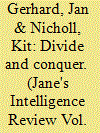

|
|
|
|
|
| Summary/Abstract |
Following a spate of long-actor terrorist attacks in mainland Europe, Jan Gerhard and Kit Nicholl examine the outlook for social cohesion and government security policy.
|
|
|
|
|
|
|
|
|
|
|
|
|
|
|
|
| 2 |
ID:
192524
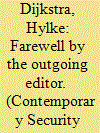

|
|
|
|
|
| Summary/Abstract |
After eight years as the Editor-in-Chief of Contemporary Security Policy, I am stepping down. Many editors have term limits imposed upon them. Others make editing their life’s work, often well into retirement. For me, it simply feels the right moment to pass the baton.
|
|
|
|
|
|
|
|
|
|
|
|
|
|
|
|
| 3 |
ID:
178943
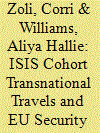

|
|
|
|
|
| Summary/Abstract |
We explore the underappreciated role of organizational tactics in terrorist violence in an understudied single case: ISIS’s execution of the November 13, 2015 Paris attacks. It is one of the first systemic reconstructions of the journeys made by two ISIS strike cohorts in the coordinated attacks, as teams traveled from the Levant to Europe. In contrast to other high-profile attacks, terrorism scholars have not undertaken a detailed reconstruction of this event, even while open source information is now available. By examining the transnational travels of foreign terrorist fighters, we identify ISIS’s distinctive terrorist outsourcing strategy in which operatives used their experiences to adapt to changing security conditions, while EU governments revealed limited responses. Both elements in this tightly-knit dynamic—terrorist outsourcing savvy using FTFs and EU security policy failures—were necessary to achieve this high-profile attack. The essay contributes to descriptive empirical and theoretical knowledge of terrorist tactical innovation and adaptive operational learning, as these capacities are enhanced by on-the-ground organized networks to increase organizational (versus lone-wolf) campaign success. By using a single case interdisciplinary and exploratory framework, terrorism studies can delve deeper into superficially understood phenomena to isolate concepts with future cross-case value, such as cohorts and tactical adaptation.
|
|
|
|
|
|
|
|
|
|
|
|
|
|
|
|
| 4 |
ID:
147108
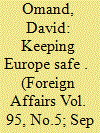

|
|
|
|
|
| Summary/Abstract |
Just before 11 PM on Thursday, July 14, a 19-ton truck turned onto a seaside promenade in Nice, France, where crowds had gathered to watch Bastille Day fireworks. The truck sped up, plowing into the people on the promenade. By the time French police shot the driver, the truck had traveled 1.1 miles, killing 84 people [1] and injuring hundreds more. That attack came less than four months after three terrorists killed 32 people in explosions in the departure hall of Brussels Airport [2] and a metro car near Brussels’ Maelbeek subway station. And it came eight months [3] after a group of young men killed 130 people in Paris, in the deadliest attack on France since World War II. The self-proclaimed Islamic State, or ISIS, claimed responsibility for all three attacks.
|
|
|
|
|
|
|
|
|
|
|
|
|
|
|
|
| 5 |
ID:
142390
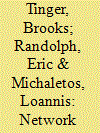

|
|
|
| 6 |
ID:
155266
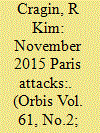

|
|
|
|
|
| Summary/Abstract |
This article provides an in-depth analysis of the role of foreign fighter returnees in the attacks by the Islamic State in Iraq and Syria (ISIS) in Western Europe. To do this, it focuses primarily on the operatives and logisticians responsible for the November 2015 attacks in Paris. The threat from foreign fighter returnees remains under-appreciated in expert and policymaking communities. ISIS’s rhetorical emphasis on the caliphate, combined with a series of attacks by lone actors, has made it easy for policymakers to misinterpret ISIS’s true intentions against the West. This case study illustrates that ISIS leaders have been able to plan and execute parallel strategies within the Middle East (Islamic caliphate) and Western Europe (terrorist campaign). Moreover, they have pursued these parallel strategies through using foreign fighters.
|
|
|
|
|
|
|
|
|
|
|
|
|
|
|
|
| 7 |
ID:
149694
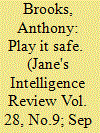

|
|
|
|
|
| Summary/Abstract |
The Paris and Brussles attacks and the Orlando nightclub shooting demonstrated the vulnerability of crowds in enclosed spaces. Anthony Brooks and Shaun Romeril analyse the evolution of event security technique, learning from the London 2012 Olympics.
|
|
|
|
|
|
|
|
|
|
|
|
|
|
|
|
| 8 |
ID:
188026
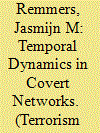

|
|
|
|
|
| Summary/Abstract |
This paper analyzes the network behind the Paris and Brussels attacks and related plots that were organized in the name of Islamic State. It answers the questions how the network was structured and how it developed over time. The database used contains highly reliable information from the judiciary and the intelligence community. It is therefore among the first to allow for statistical analysis of the typology of a covert network, while also being reliable and detailed enough to admit for an analysis of the covert network chronological development. The findings are that the network was centralized and thus vulnerable to targeted attacks against the most central nodes. The network developed in three phases: (1) construction of local cells, predominantly based on pre-existing ties; (2) travel to Islamic State and merger with a larger network; (3) consolidation before carrying out an attack. In addition, it is found that (1) most network analyses of covert networks understate the importance of peripheral nodes, and (2) that analyzing the final configuration of the network alone does not necessarily lead to correct conclusions, as it ignores the underlying structures of pre-existing networks.
|
|
|
|
|
|
|
|
|
|
|
|
|
|
|
|